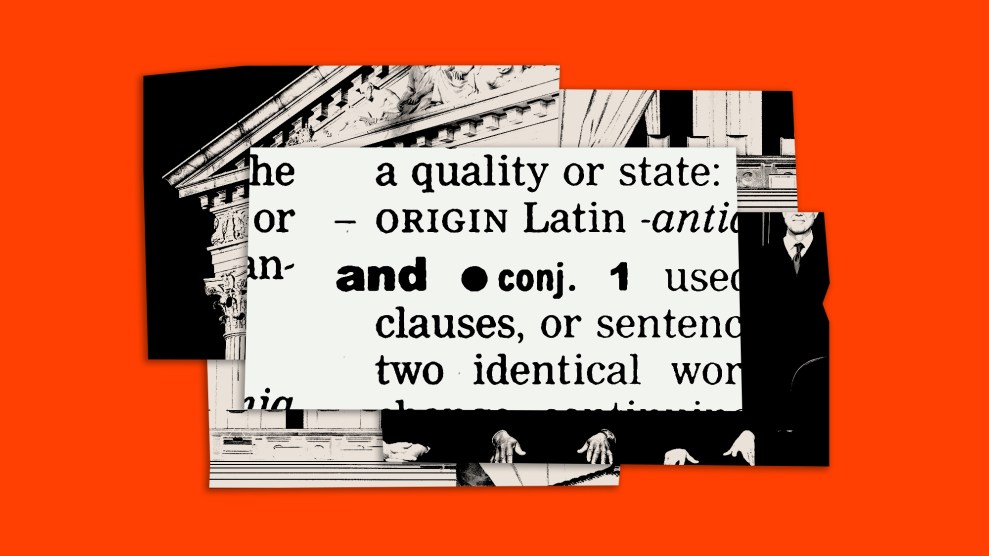
Mother Jones; Erin Schaff/The New York Times/AP; Unsplash
It’s a riveting, baffling, and/or solemn day in this country when the highest court must step in to adjudicate a definitional dispute as basic as this: Does “and” mean “and”? Or does it mean “or”? Lower courts want to know. As do legal scholars, criminal defendants, and copy editors everywhere.
The Supreme Court heard oral arguments yesterday in Pulsifer v. United States, a case that turns on a federal law’s use of “and.” Circuit courts are divided over what the word means in a statute aimed at reducing mass incarceration through an array of criminal justice reforms. For thousands of defendants, eligibility for relief from mandatory minimum sentencing depends on whether “and” in a provision of the landmark First Step Act was deliberately or mistakenly written to conjoin requirements for reduced prison time—and to what extent Congress’ intent matters.
Below is the fine print. Don’t let your head spin. There’s math involved, plus parsing of semicolons and em dashes. But one hopes the Supreme Court justices, in their nontrivial copy-edit wisdom, can swiftly untangle this knot. (“Points” below refers to the system of sentencing based on points assigned to past crimes and current crimes being sentenced for.) A defendant is eligible for relief if:
the defendant does not have—
(A) more than 4 criminal history points, excluding any criminal history points resulting from a 1-point offense, as determined under the sentencing guidelines;
(B) a prior 3-point offense, as determined under the sentencing guidelines; and
(C) a prior 2-point violent offense, as determined under the sentencing guidelines;
Taken at face value, defendants qualify for relief if they do not simultaneously meet all three conditions, because “and” bundles them. But read differently, “and” could be construed to mean that any of the conditions satisfies the “does not” test—if “does not” distributes across them, and, by implication, if Congress meant “and” to function as “or.” And this isn’t pedantic. Vastly different prison outcomes are at stake. More than 10,000 people sentenced in recent years could be affected.
Lawyers for the petitioner, Mark Pulsifer, who pleaded guilty to felony drug distribution with a prior conviction, argued he should be granted relief because “‘and’ is still conjunctive” after the negative “does not,” much like “Don’t drink and drive” would mean you could maybe do either but can’t do both. His lawyers cited that analogy, but the First Step Act punctuates unclearly, as in “Don’t—(A) drink; and (B) drive.” Would that mean don’t drink and don’t drive, instead of merely not doing both at the same time?
Justice Elena Kagan tackled that very example during Monday’s oral arguments, comparing it to a hypothetical medical test:
So you’re going in for a medical test and you receive something from the hospital, and it says, to receive this test, the patient should not, and then, you know, it has a list of things that the patient shouldn’t do, and it says the patient shouldn’t eat any food, drink any liquids, and smoke. So I’m going to assume…that you’re not a smoker. Do you feel perfectly able to eat and drink as much as you want?
Kagan suggested that this hypothetical hospital’s use of the word “and”—and perhaps, by extension, the First Step Act’s “and”— would be “different from an example like drink and drive” because “there’s something that connects those two [verbs] so that we know that the harm comes from the relationship between the two, whereas in this case we know that the harm follows from any one of the things. Either way you’re using context to establish meaning, aren’t you?”
Kagan’s framing is the crux of the controversy: Appellate courts for the 4th, 9th, and 11th circuits have read “and” conjunctively, which would lighten prison sentences. But the 5th, 6th, 7th, and 8th circuits have come down differently, interpreting “does not” as distributive across the three conditions, which would deny relief to defendants who meet any of the provision’s conditions. This approach would make mathematical sense of the First Step Act. The law’s calculations are confusing because someone with both the 3-point offense from (B) and the 2-point violent offense from (C) would have at least 5 points and would automatically exceed the 4 criminal history points in (A)—making (A) meaningless or extraneous. To give (A) meaning, some courts have said “and” has to mean “or.” But does it?
I’ve asked several legal scholars. (Disclosure: A family member of mine is a circuit court judge who has ruled on this law, but we have not discussed the case, the statute, this article, or theories of textualism, and I learned of Pulsifer only through a newsroom colleague.)
Pulsifer presents, “at least plausibly, a situation in which Congress simply misspoke” by “substituting ‘and’ for ‘or,’” says Harvard Law professor Ryan Doerfler in an email, “but because existing doctrine requires such linguistic mistakes (known as ‘scrivener’s errors’) to be unmistakable, the government is forced to argue that Congress’s wording in the statute is precise but that the statute is disjunctive nonetheless.” And the government’s case is conceivable. It is possible “that Congress meant the statute to read ‘the defendant does not have (A); (the defendant does not have) (B); and (the defendant does not have) (C).’”
“Scrivener’s errors” are legislative drafting mistakes. It is widely accepted for courts to correct them if the mistakes are absolutely clear, Doerfler has written. But the risk of courts rewriting law rather than correcting mere drafting mistakes is tremendous. That would constitute a staggering judicial overreach—especially in a criminal context—so the bar is purposefully high for courts to fix legislative errors. But is the bar too high? Doerfler has argued that the standard is indeed “much too strict” because it prevents judges from recognizing legislative typos. In their efforts not to rewrite law, courts can misinterpret text by failing to name drafting errors in the law, a pendulum swing past the best balance. So some courts assert themselves by interpreting “and” as “or.”
“I’m sure [this legal dispute] seems strange to a copy chief,” says professor Erica Zunkel of the University of Chicago Law School. “How crazy to ask whether ‘and’ actually means ‘and’ or if it means ‘or.’ Only in law…(or if you’re a U.S. President).”
“Sometimes Congress doesn’t do a great job drafting legislation that is clear and unambiguous and there can be serious implications for people’s freedom when that happens,” she says. “One of the reasons there’s even purported ‘ambiguity’” in Pulsifer “is that there’s an instinct to assume that Congress can’t possibly have meant to expand relief for individuals charged with drug offenses so much.”
“In many charging contexts, ‘and’ is regularly interpreted as ‘or,’” says Daniel Richman, a Columbia Law professor and former federal prosecutor. “It is also a world in which, not surprisingly, judges are quite open to interesting arguments that, if accepted, would increase judicial discretion to put aside mandatory minimums.”
The court has become “more and more obsessed with language and grammar in recent years,” says Stanford Law professor Jeff Fisher. “Oral argument these days can seem like being in a sixth grade English class.”
“The Court has had cases, for example, that turned on the word ‘so’” and “the use of a definite article instead of indefinite (‘the’ instead of ‘a’),” he says. “This is all a product of the ascendancy of ‘textualism’—the theory of statutory construction that aims to discern precisely what the words Congress enacted mean, as opposed to what Congress probably intended to say.”
Pulsifer captures top-court attention “in no small part because a majority of judges to address the issue have said that ‘and’ in fact does mean ‘or,’” says professor Adam Davidson, also of the University of Chicago. The rise of textualism has led “some conservative justices to liberal outcomes in recent cases.” He cites Bostock v. Clayton County, the civil rights case that centered on defining “sex”; Niz-Chavez v. Garland, the immigration case that atomized the single letter “a”; and Borden v. United States, the sentencing case that parsed the word “against” in a federal statute.
The Supreme Court hears “lots of cases [that] turn on the meaning of a single (common) word,” says Aziz Huq, also a University of Chicago law professor. “There’s a famous case that all law students read in contracts about what the word ‘chicken’ means; I used to teach a class on what ‘fruit’ meant in a federal statute.”
“And” clashes are not new. Justice Department litigators have long seen this day coming and kept a department playbook for defining the word. The Criminal Resource Manual, now archived, says exactly how and when to deploy certain interpretations of “and” for preferred outcomes. And grammatical lawsuits are increasingly common, from the $5 million settlement in a serial comma clash to an attempt to overturn Obamacare based on an apparent drafting error; the wrangling over the Second Amendment’s syntax; and the comma collision in a federal robocall ban.
This is all a big problem, Doerfler says, not because precise word choice isn’t important for encoding policies in law, but because written language invites competing interpretations. Linguistic analysis only gets you so far. Atomization of words cannot resolve every textual dispute, but “because the Court today feels either compelled or entitled to pretend that legal [linguistic] analysis can resolve every dispute it is presented with, the Court’s linguistic analysis is, in my view, frequently stilted as it attempts to present statutory language as linguistically clear when, in reality, multiple readings are entirely plausible,” he says.
As you were, copy editors. Your democratic duty is robust and/or recognized. Listen to the arguments, read the transcript, and send outcome predictions to styleguide@motherjones.com.













